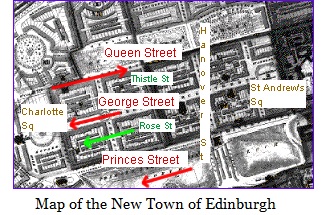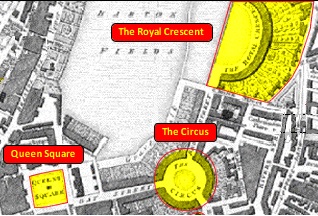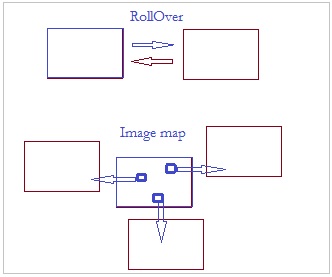URBAN DESIGN: OVERVIEW
We shall study the history of townscapes in Britain in the 18th century, a period when in several major cities - primarily Bath, London and Edinburgh - new areas were built, and a flourishing social life developed. We shall use online material and experiment with interactive maps:
- Online supporting material on urban history authored by our Research Centre: the Georgian Cities website
We shall study such topics using the Georgian Cities website http://www.18thc-cities.paris-sorbonne.fr/index-3.php : bookmark it as we shall use it continually. You may find a presentation of the project on the website of our Research Centre CSTI.
Georgian Cities is a hypermedia website on 18th-century urban culture, containing chapters on each of the major cities, with pages on topics such as architecture, society, literature and music ... illustrated by texts, images and recordings. It thus gives a multi-faceted view of cities, related to the field of 'urban studies' which have developed in recent decades, combining history, geography, the study of urban design and cultural history.
This is a summary of the main points we shall first study on the Georgian Cities website:
- An introduction to Georgian urban design on the web - the example of Edinburgh
For the present chapter, we shall first study the history of the neoclassical New Town of Edinburgh (built from 1767 onwards) with its straight perpendicular streets offering vistas - a 'gridiron' plan -, which you may view on the map: on the image space below, roll your pointer over and out to see the map alternating with the photo.

*The history of cities and townscapes represented on the web:when you rollover the map of Edinburgh above, you see a photo of the main view: from George Street towards Charlotte Square - the middle red arrow on the map. The 'RollOver' process gives two views of a place, one as a map and one as a photo, prompting us to relate them. Here the map of the 'New Town' of Edinburgh reveals the geometrical approach of late 18th-century town-planning, while the photo is meant to show the result on the ground - straight vistas.
- The architectural features of urban design in Bath and in London: Then we shall study Bath, where new areas were built with architectural features such as Queen Square, the Circus (a circular area surrounded with houses) and the Crescent (a curved colonnaded street).

* Online representation of the cityscape: as urban studies arose, digital media have offered new ways of visualising cityscapes, giving multiple views of them - through cartography, animated images, interactive options, as in the example above relating the map and a photo of Edinburgh. You will find many of them in the Georgian Cities website; on the website, the map of Bath (of which you have a screenshot here) is an 'image map', where the red labels corresponding to Queen Square, the Circus and the Crescent are 'hot spots' leading to pages on the corresponding buildings.
Such effects may highlight the interaction between architecture and vistas through the centuries, streets and people or townscapes and activities with their geographical location, society and urban culture. We shall explore some of the issues thrown into relief in digital cityscapes- and highlight contemporary approaches to the topic. To summarise:
- rollover: one image is replaced by another, giving alternate pictures
- image map: a large image (for instance a map of a city) has several 'hotspots' each leading to a different image (a view of each of the buildings on the map marked by the hotspots); here one image leads to many other images

Then we shall study London, where the square surrounded by houses in similar style became a feature of urban development.
-- To access the web pages of Georgian Cities on each of the three cities, in the website http://www.18thc-cities.paris-sorbonne.fr/index-3.php, after the opening animation of the fan, click on 'Edinburgh' in the menu bar on top and study the section; start with the 'Maps' and 'Architecture' pages. Then move to 'Bath' and 'London' similarly from the menu bar.